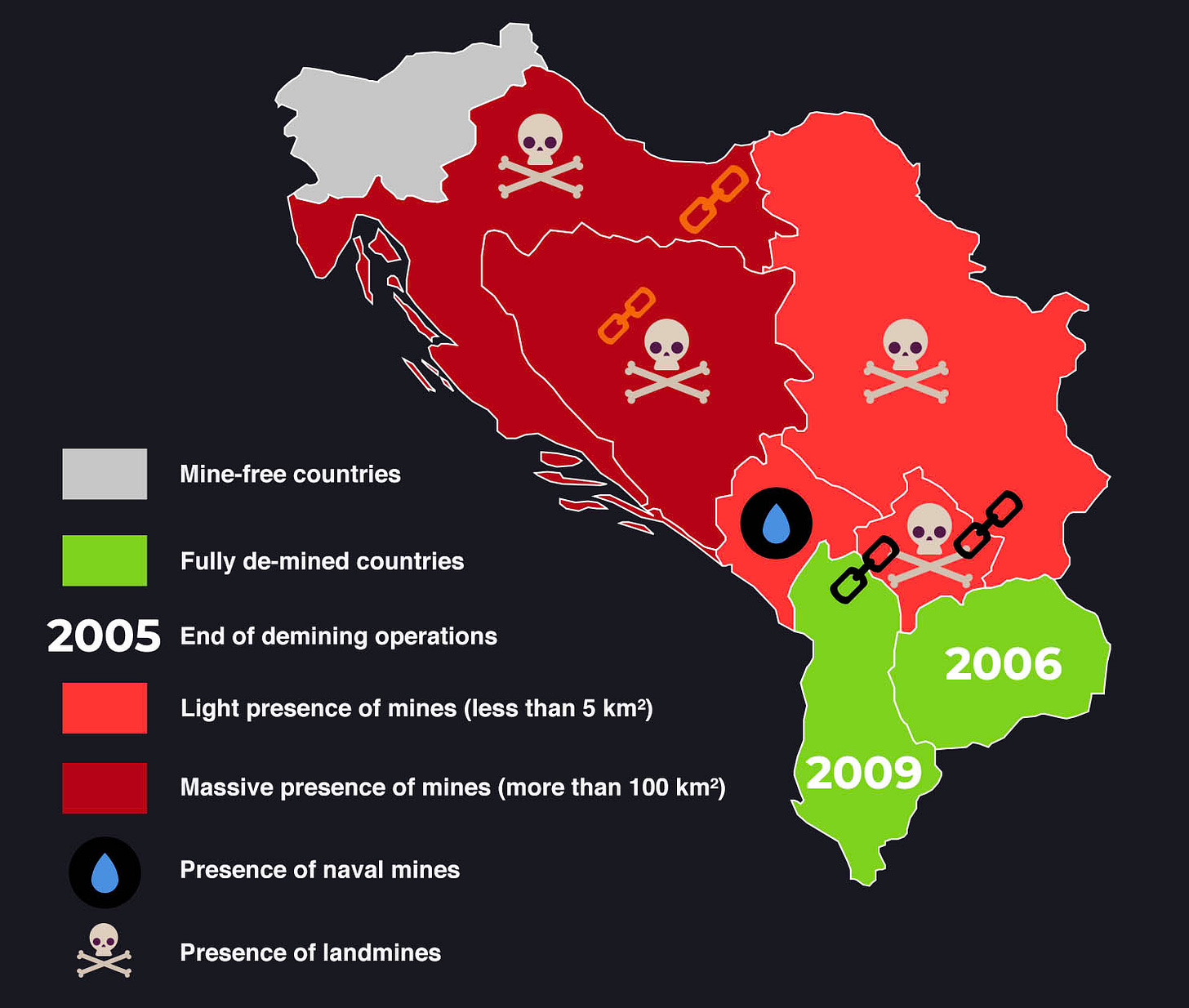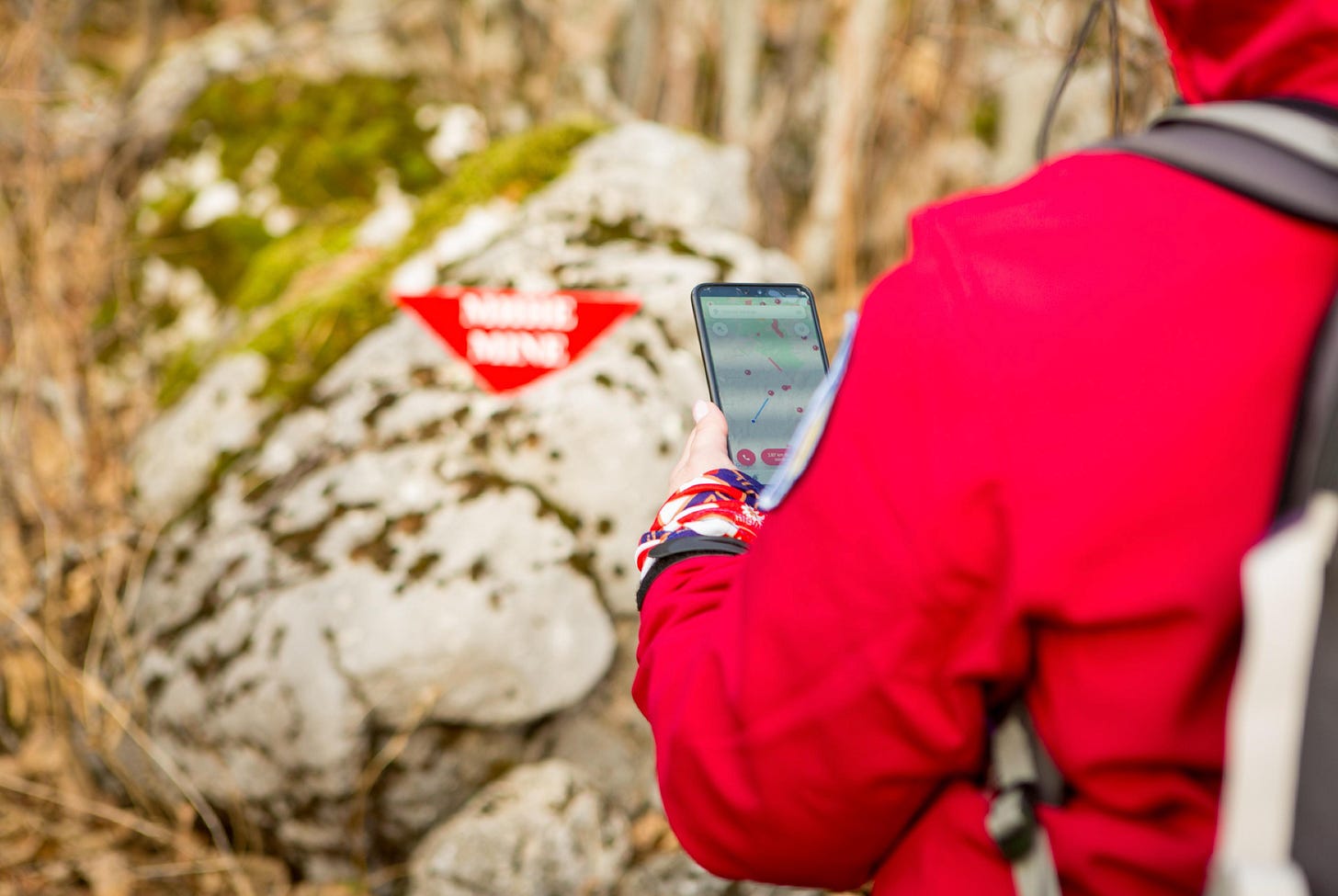S3E15. The invisible threat
Thirty years after the Yugoslav Wars, people can still die from exploding mines and cluster bomb remnants on the ground. The minefields in the Western Balkans cover an area as wide as the city of Rome
Hi,
welcome back to BarBalkans, the newsletter (and website) with blurred boundaries.
“Pazi - Mine / пази - мине”.
If you happen to be in the Western Balkans and you read these words - written in white on a red sign, with the symbol of a skull and two crossed bones - then stop. And do not take a single step forward.
Because you are in front of a minefield. A forest, a wasteland, a path with mines or cluster bombs remnants on the ground.
This is much more common than you might imagine.
Thirty years after the ethnic wars in the former Yugoslavia, civilians are still losing their lives because of political responsibility, carelessness or lack of funding for mine clearance operations.
If you would like to learn more about the Yugoslav Wars in the Nineties without too much effort, I would like to remind you that BarBalkans has been developing a parallel project, BarBalkans - Podcast, since January 2021 (you can find all information here).
Month by month, BarBalkans - Podcast takes us back to the dissolution of Yugoslavia - in that very month, but 30 years ago - following the fate of recent Balkan and European history.
Find out if you like the idea of the time machine. Here you can find the latest episode, open for public reading: March ‘93. Signed in blood
With a small donation, you can receive the article-podcast in your e-mail every second Wednesday of the month. The preview is always available for free on Spreaker, Spotify and all streaming platforms.
If you want to start learning about the history of the Yugoslav Wars, you can subscribe here:
The silent consequences of the war, 30 years later
The latest tragedy in Croatia happened on January 15.
Some 40 kilometers north of Split, in the Dalmatian hinterland, a 67-year-old hunter died after stepping on an anti-personnel mine placed at the time of the Serbian Republic of Krajina.
In March last year, a migrant person was killed in the forests near the Plitvice Lakes - close to the border with Bosnia and Herzegovina - unaware of the presence of unexploded ordnance in the region of Krajina.
These are the latest victims of a tragedy that is ongoing since 1991, when the war broke out between the Republic of Croatia and the disintegrating Socialist Federal Republic of Yugoslavia.
And we are not talking only about Croatia, but almost the entire territory of the former Yugoslavia and along the borders of Albania. Only Slovenia, the first Socialist Yugoslav Republic to separate from the Federation (in just 10 days) has not experienced this drama.
The most affected country is Bosnia and Herzegovina, where more than 120 thousand mines in rural areas represent a threat to some 540 thousand citizens. Nearly one out of five Bosnians can risk their lives every day, if they are not careful.
In Kosovo and Serbia the risk is still high, but decreasing. Montenegro is now de-mined, but still with some areas of danger. Albania and North Macedonia, on the other hand, have eradicated the problem for several years.

Considering the postwar data, it seems that another silent and daily war is going on, where innocent people can die or be injured - as in every conflict - but with no guns firing.
Since 1995 - when the wars in Croatia and Bosnia ended - and since 1999 in Kosovo, Serbia and Montenegro (and by extension also in Albania and North Macedonia), there have been more than 6,240 casualties of landmines and cluster bomb remnants.
According to Landmine & Cluster Munition Monitor data, Bosnia counts 1,766 casualties and Croatia 1,434 (until 2020). In Serbia 1,360 casualties, nearly 1,000 in Albania - which was neither part of Yugoslavia nor a belligerent country, but whose borders were a sensitive target for the Serbian military because of its proximity to Kosovo - 590 in Kosovo and 18 in Montenegro. Between 1999 and 2006 (when mine clearance operations ended) 82 were counted in North Macedonia.
Anti-personnel mines and cluster bombs remnants are the cause of all of this.
Anti-personnel mines are explosive ordnance placed on the ground or underground. They are propelled by pressure (of a vehicle or foot), leading to an explosion. The use, stockpiling, production and transfer of anti-personnel mines are banned by the 1997 Ottawa Treaty. Within 10 years of the Convention’s entry into force in a specific State, all anti-personnel mines have to be destroyed.
On the other hand, cluster bombs are air-dropped or ground-launched explosive weapons, that release or ejects smaller submunitions. The unexploded remnants are potentially deadly for decades. Cluster bombs are banned by the 2008 Oslo Convention.
All Balkan countries have signed the Anti-Personnel Mine Ban Convention. Only Serbia has not signed the Convention on Cluster Munitions.
As the entire city of Rome
But how extensive is the problem in the Balkan region, territorially speaking?
Again, Landmine & Cluster Munition Monitor, a civil society initiative on anti-mine and anti-cluster bomb policies, gives us a measuring scale.
With the exception of Slovenia - the only Balkan country ever mined - only North Macedonia and Albania have completed demining operations, respectively in 2006 and 2009.
For Montenegro, the problem is relatively marginal: here, there are no landmines, but a few limited areas with naval mines and 1.72 square kilometers littered with cluster bomb remnants. In Serbia, 3.24 square kilometers are affected by deadly ordnance.
The situation is more problematic for Kosovo, with “only” 1.35 square kilometers at risk of mines, but 14.34 covered with cluster bomb remnants.
However, the most affected countries are always Croatia and Bosnia. Here, the war dragged on longer and with armies and political entities better equipped to conduct a dirty war.
An area of almost a thousand square kilometers, 968.99 to be exact, is mined in Bosnia and Herzegovina. While in Croatia, an area of 279.55 square kilometers.
Overall, in the Western Balkans 1,269.19 square kilometers are mined.
You need a benchmark?
As if the entire metropolitan area of Rome were covered with mines.
In order to succeed in completely demining a “potentially explosive Rome in the Balkans”, funds from the EU long-term budget may be decisive.
Croatia - the only country in the Western Balkans that is also a EU Member State (along with Slovenia, not affected by this problem) - shows it clearly. Authorities in Zagreb plans to cover with EU funds 60% of mine clearance operations, which will cost 1.2 billion euros by 2026.
The goal is to clear at least one-third of forest areas - that represent almost all of the mined areas - with EU funds allocated to Cohesion Policy, to fully secure the proximities of national parks.
A virtuous example is the Fearless Velebit project, conducted within the Operational Program Competitiveness and Cohesion 2014-2020. The aim is to clear two areas in the hinterland of Senj and Zadar, between the Adriatic Sea and the border with Bosnia.
The project is scheduled to end in June 2023, but demining operations were already completed in December 2020. In Paklenica National Park and Velebit Nature Park, 1,645 hectares have been secured and 2,177 unexploded mines and lethal ordnance removed.
But other EU-funded projects can also be decisive for the everyday lives of citizens and people who travel in the Western Balkans, waiting for the entire region to finally be mine-free.
For example, the app Bosnia and Herzegovina Mine Suspected Areas (you can download it here). It has been developed thanks to two projects funded by the EU Instrument contributing to Stability and Peace (IcSP), to map and make easily accessible knowledge of mine suspected areas, that have to be avoid throughout the country.
This is one of the many ways to try to put an end to the consequences of wars that - technically - are already over. But that still affect the entire region, almost 30 years later.
Pit stop. Sittin’ at the BarBalkans
We have reached the end of this piece of road.
As we have talked about mines and the urgent need to clear territories still compromised by past wars, our silent fellow travelers are bees.
Because bees are extremely intelligent insects, that can be trained to recognize and fly over unexploded mines, making it easier for minesweepers to clear them.
This is why today at our bar, the BarBalkans, we tribute bees with medovača, a type of rakija based on their best-known production: honey.
This is a distillate with a high percentage of honey in relation to alcohol. No added sugar is needed and the color is a deep golden yellow.
Medovača is part of the rakija family, spirits realized by fermentation and distillation of fruit, or flavored with natural methods (as in the case of medovača, with honey).
Let’s continue the BarBalkans journey. We will meet again in two weeks, for the 16th stop.
A big hug and have a good journey!
Your support is essential to realize all that you have read. And even more.
Because a job well done - always aiming to improve - needs many hours and energy, also to keep BarBalkans newsletter free for everyone.
An independent project like this cannot survive without the support of the readers. For this reason I kindly ask you to consider the possibility of donating:
Pay attention! The first time you will receive the newsletter, it may go to spam, or to “Promotions Tab”, if you use Gmail. Just move it to “Inbox” and, on the top of the e-mail, flag the specific option to receive the next ones there.








